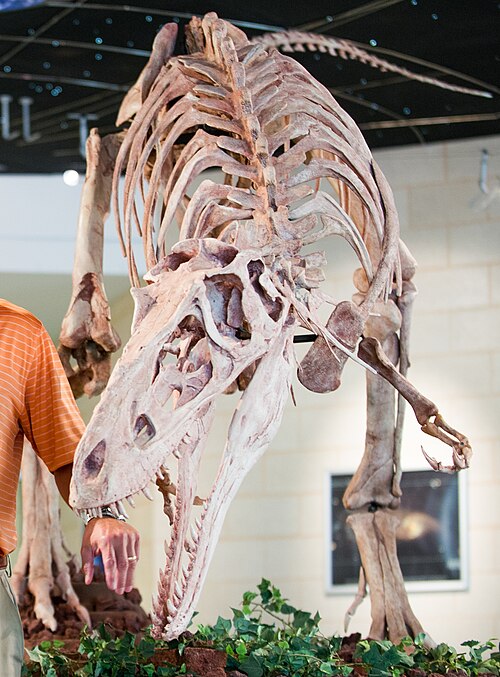Facts for Kids
Alioramus is a Late Cretaceous theropod dinosaur known for its slender build and distinctive skull features, found primarily in Mongolia.
Overview
Habitat And Distribution
Physical Characteristics
Diet And Feeding Behavior
Behavior And Social Interaction
Comparison With Other Dinosaurs
Research And Future Discoveries
Fossil Discovery And Significance
Cultural Impact And Representation

Inside this Article
Tyrannosaurus
Velociraptor
Imagination
Gobi Desert
Information
Technology
Community
Skull
Speed
Did you know?
🦖 Alioramus was a theropod dinosaur that lived during the Late Cretaceous period.
🏞️ Fossils of Alioramus have been primarily found in Mongolia.
🔍 It is known for its long, slender skull and relatively large number of teeth.
🏋️ Alioramus had a lightweight build, suggesting it was a fast runner.
👥 Some paleontologists believe Alioramus was a pack hunter, hunting in groups.
🌟 It was a member of the dromaeosaurid family, related to modern birds.
🔨 Alioramus had unique skull features, including large, forward-facing eyes.
📏 Estimates suggest it could grow to about 6 to 7 meters in length.
🦷 Alioramus had a distinctive dentition, with many sharp teeth for tearing flesh.
🌍 It's believed that Alioramus occupied a niche similar to modern-day predators.
Introduction
It was a small carnivorous dinosaur found in what is now Mongolia. Alioramus belonged to the theropod group, which means it walked on two legs and was closely related to larger dinosaurs like Tyrannosaurus rex! With a long, slender head and sharp teeth, Alioramus was a quick predator. Some scientists believe that it may have hunted smaller dinosaurs and other animals. Isn’t it exciting to think about how this dinosaur roamed the Earth when dinosaurs were the rulers of the land? 🌏
Habitat And Distribution
During the time of Alioramus, the climate was warmer and wetter, creating lush areas filled with plants. This environment supported a variety of dinosaurs and other creatures. The Gobi Desert is famous for being a treasure trove of dinosaur fossils, and that's where many scientists found remains of Alioramus! These discoveries help us understand where these amazing creatures lived and how they adapted to their surroundings thousands of years ago.
Physical Characteristics
Diet And Feeding Behavior
Its long, sharp teeth were perfect for catching and eating other small dinosaurs and animals that lived around it. Scientists think it may have hunted in groups, similar to how some pack animals do today, making it easier to chase down prey. Alioramus had a keen sense of sight and smell, which helped it find food. It may have used its speed and agility to sneak up on its meal. Learning how Alioramus fed gives us clues about its life and how it interacted with the ecosystem!
Behavior And Social Interaction
Being in a pack could help them hunt better and protect each other from larger predators. Imagine a group of Alioramus dinosaurs running together in search of food! They might have used various sounds and body language to communicate with one another. This social behavior is similar to modern birds, which are also descendants of dinosaurs. With this in mind, we see how Alioramus may have interacted with its friends and family in a prehistoric world, creating a community.
Comparison With Other Dinosaurs
While T. rex was massive and intimidating, Alioramus was much smaller and faster. Both dinosaurs belonged to the theropod group but had different hunting strategies and lifestyles. Other small theropods, like Velociraptor, also had some similarities, such as their sharp teeth and agile bodies. By comparing Alioramus with these well-known dinosaurs, we can learn how different species adapted in unique ways to survive in a dinosaur-filled world. It's like seeing the differences between various animals today!
Research And Future Discoveries
New technology, like 3D scanning and computer modeling, helps researchers analyze fossils in detail. As more dinosaur fossils are uncovered each year, we can discover new species or learn more about known ones like Alioramus! Each find adds to our understanding of how dinosaurs lived, changed, and interacted with their environment. With so much still to explore, who knows what future discoveries will reveal about the exciting world of dinosaurs? Keep searching for answers, young explorers!
Fossil Discovery And Significance
Archaeologists found a nearly complete skeleton, which was amazing because it gave them a lot of information about this dinosaur. Studying these fossils helps scientists learn about dinosaurs' physical appearances, how they lived, and how they evolved over time. Fossils are like pieces of a puzzle that help us understand the past! Discovering Alioramus was important because it added to our knowledge of theropod dinosaurs and how they adapted to their environment.
Cultural Impact And Representation
They are featured in books, movies, and toys. Many kids love dinosaurs, often learning about them through fun stories and cartoons. Authors and filmmakers use dinosaurs to spark imagination, creating exciting adventures. Alioramus itself might not be as famous as T. rex, but it’s part of the same colorful world of dinosaurs! Understanding dinosaurs helps us appreciate our planet's history and fuels our creativity, inspiring artists and scientists everywhere to explore the mysteries of the past!

